Your No-Nonsense Guide to PLM Software Development in 2024

How do you bring your products to market to 2024? If your take-offs resemble a hodgepodge of misaligned processes, escalating costs, and room for error, your products are already in jeopardy. And things may go from bad to worse post-launch. In fact, 95 out of 100 new product launches go south. But there’s one tip to ensure yours is among the lucky 5%: product lifecycle management software.
You’ll be surprised to discover how dramatically this software can improve the processes as you develop, launch, and maintain your products. Right on cue: it simplifies the management of product lifecycle stages while saving you money.
Relevant is a professional product development company with years of experience in building and maintaining software solutions. We couldn’t leave you without a guide on PLM software development and an explanation of how to create these practical systems. So here you go.
What are PLM systems and the PLM process?
Product lifecycle management is a comprehensive process of managing a product as it advances from one stage to another. It helps you control and steer its direction as you plant the seeds of an idea, watch them grow during product development, and harvest the fruits until your product is discontinued.
As products become more intricate, an abundance of processes is involved in creating them and overseeing their lifecycles. That’s why everyone is looking to software to better organize things.
Product lifecycle management systems are here to do just that. They help you handle the intricacies of the PLM process, taking your product to the next level during development, release, and service stages—all the way to the end of its life. And you can use this software for virtually any product, whether an air pollution monitor or electric vehicle.
How is the PLM app development market doing?
The state of the PLM software market typifies the lay of the land in today’s digitally inclined business world. No surprise that digitalization triggers its growth, with the latest milestone set at $32.42 billion in 2026.
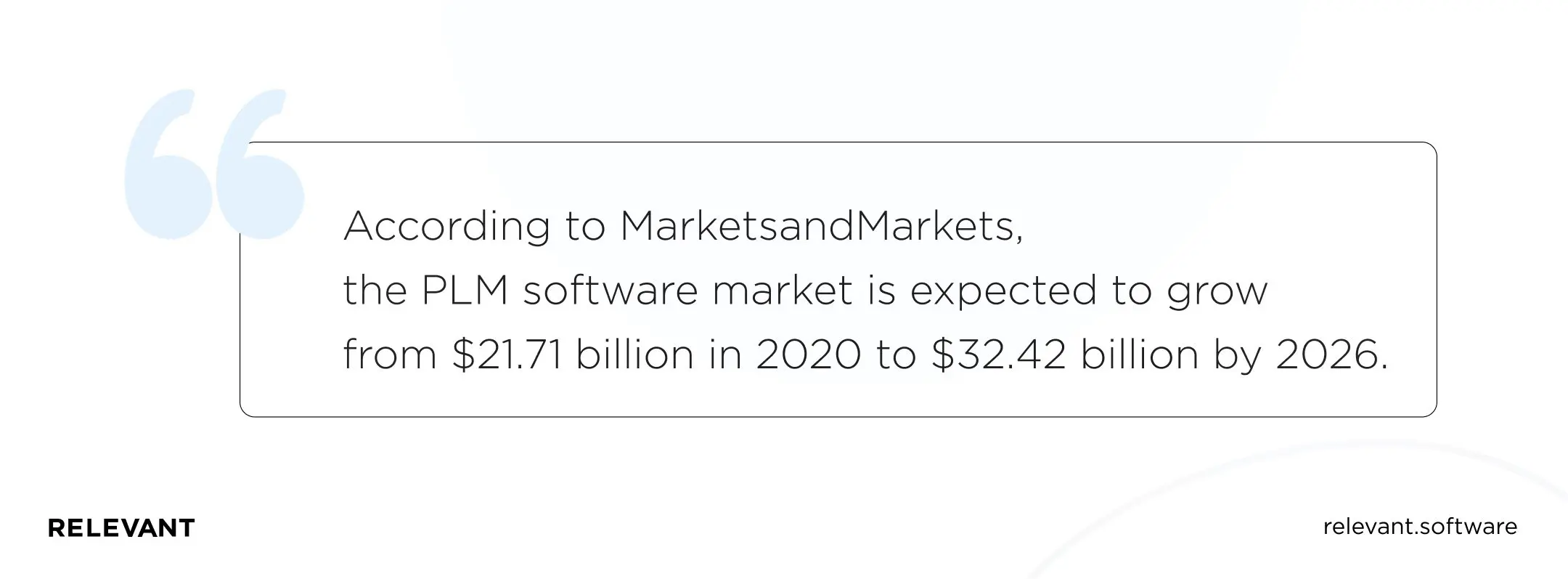
What does this mean for you? The booming market is a welcome sign. Because it’s not oversaturated and has many top-rated players, now may be the best time to adopt a PLM system as part of your digital transformation journey.
Businesses steadfastly embrace PLM systems in manufacturing, automotive, engineering, and other industries. Quite often, they opt for the PLM software-as-a-service (SaaS) model in an attempt to snatch a souped-up solution straight out of the oven.
Here are five big-shot product lifecycle management software companies today:
- Siemens Digital Industries Software
- Upchain
- Autodesk
- Propel
- Arena
These vendors offer cloud-based PLM software, mostly for manufacturers. That means you can get your foot in the PLM door merely by selecting a plan and implementing an existing solution on your devices. If you’re in two minds, you can even give each of the SaaS PLM providers a test run. Although they don’t offer free PLM software, time-limited free trials are on the menu.
A word of caution: cloud-based solutions come with the features PLM vendors have crammed into them. You can’t change them or add any new functionality to an existing system. If you want to call the shots with your PLM, you may need a custom solution instead of SaaS software.
Why and when should you adopt PLM software development?
Do you remember the days before spreadsheets? The ineffective days of fax machines and phones that seemed to never stop ringing? Well, PLM software now takes the place of spreadsheets, just like they replaced outdated product management methods in the name of productivity.
Here’s why you want to have software behind your PLM:
- Ensuring your product launch is predictable and fast. PLM software reduces friction between your departments and supply chain partners. It serves as a single workspace where everyone can do their job while keeping others in the loop, getting around the roadblocks, and bringing a product to market.
- Refining your product based on data-driven insights. There’s a lot more to do after launching a product. When your customers get their hands on it, you’ll likely need to work out design improvements based on their feedback. With PLM software, you can monitor all changes and refinements while bringing your product to its next level.
- Automating tedious tasks. Every product lifecycle management solution is born out of a need for more effective processes. To this end, it automates the way your teams exchange documents, communicate, and track KPIs throughout your product’s journey. This solution can also help monitor product approval status, which is a major concern for manufacturing and pharmaceutical companies.
- Steering clear of product management mistakes. Even a tiny mistake can sabotage your product success. PLM software is like an additional control system behind your design, manufacturing, and sales processes. It helps you avoid product non-compliance risks and other issues caused by human error or negligence during production.
- Reducing design and production costs. With a fully integrated PLM software solution, you can keep costs down at every product lifecycle stage. For example, when your engineers edit a blueprint, your procurement team stays up to date on new materials that need to be bought, along with their exact quantities. There’s no risk of getting trapped in an excess inventory situation or realizing you lack the materials to create a product in the middle of the production stage.
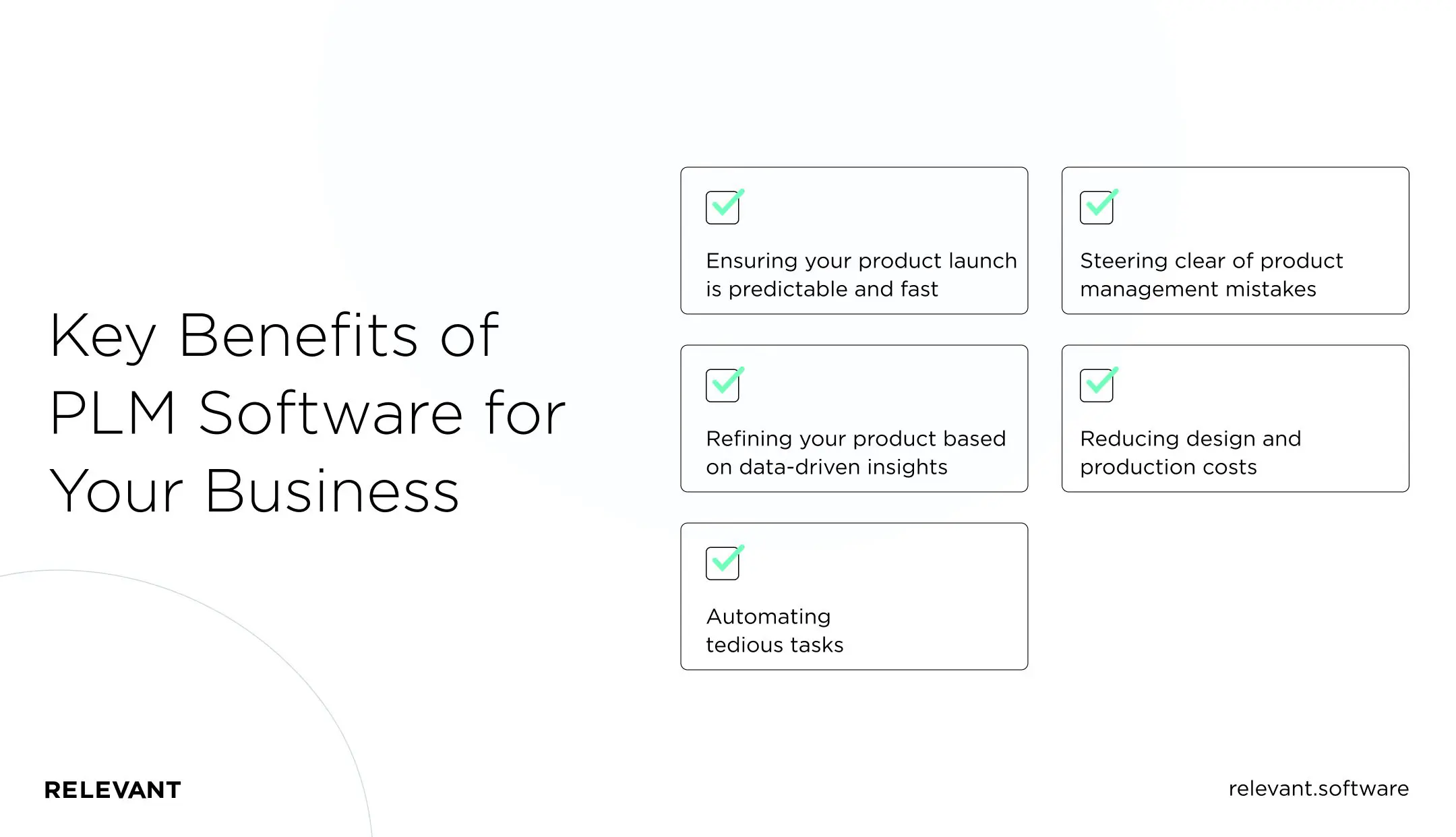
If you’re still mulling over getting started on PLM software, here are a few signs you maybe should have done it already:
- It took way more time to bring your latest product(s) to market than expected.
- Some of your promising product(s) failed at the production or launch stage.
- You floundered financially because of inaccurate product development cost estimates.
- Your teams and partners couldn’t communicate effectively, causing a launch delay.
- You had to discontinue your product(s) before it reached maturity.
- Your customer satisfaction rating went down because you failed to redesign or otherwise improve your product(s) based on your audience’s input.
All this can be avoided with PLM software. It pays dividends as long as your teams collaborate on a product and makes sure you’re aware of what’s going on throughout its lifecycle.
Product lifecycle management app development: Features, steps, integrations, and challenges
Embracing PLM isn’t an overnight process, nor is it a walk in the park. You should have a firm grasp of the matter before looking for a dedicated development team or signing up for ready-made software.
What does PLM software do, and how does it work?
In a nutshell, PLM systems organize everything you do throughout your product’s lifecycle. But what is PLM software used for in context?
Imagine you’re on the verge of introducing a new product to your audience. Your desks are littered with documents, your teams are freaking out over the dearth of materials, and you haven’t even gotten around to commercialization tasks yet.
PLM shelters you from a nervous breakdown. It combines your documents, timelines, cost estimates, data, and processes under one roof and connects all your teams and supply chain partners. Things look up when topsy-turvy workflow becomes manageable again.
Common PLM features and capabilities
The features you want to have in your PLM software should mesh with the industry you’re involved in, your product subtleties, and workflow requirements. Most likely, these are your bread and butter:
- Comprehensive project dashboard
- Chats, messengers, conferencing tools, and other collaboration features
- Product lifecycle status tracking
- Central hub for data and documents
- Cost estimation
- User roles configuration
- Material use tracking
- Reporting
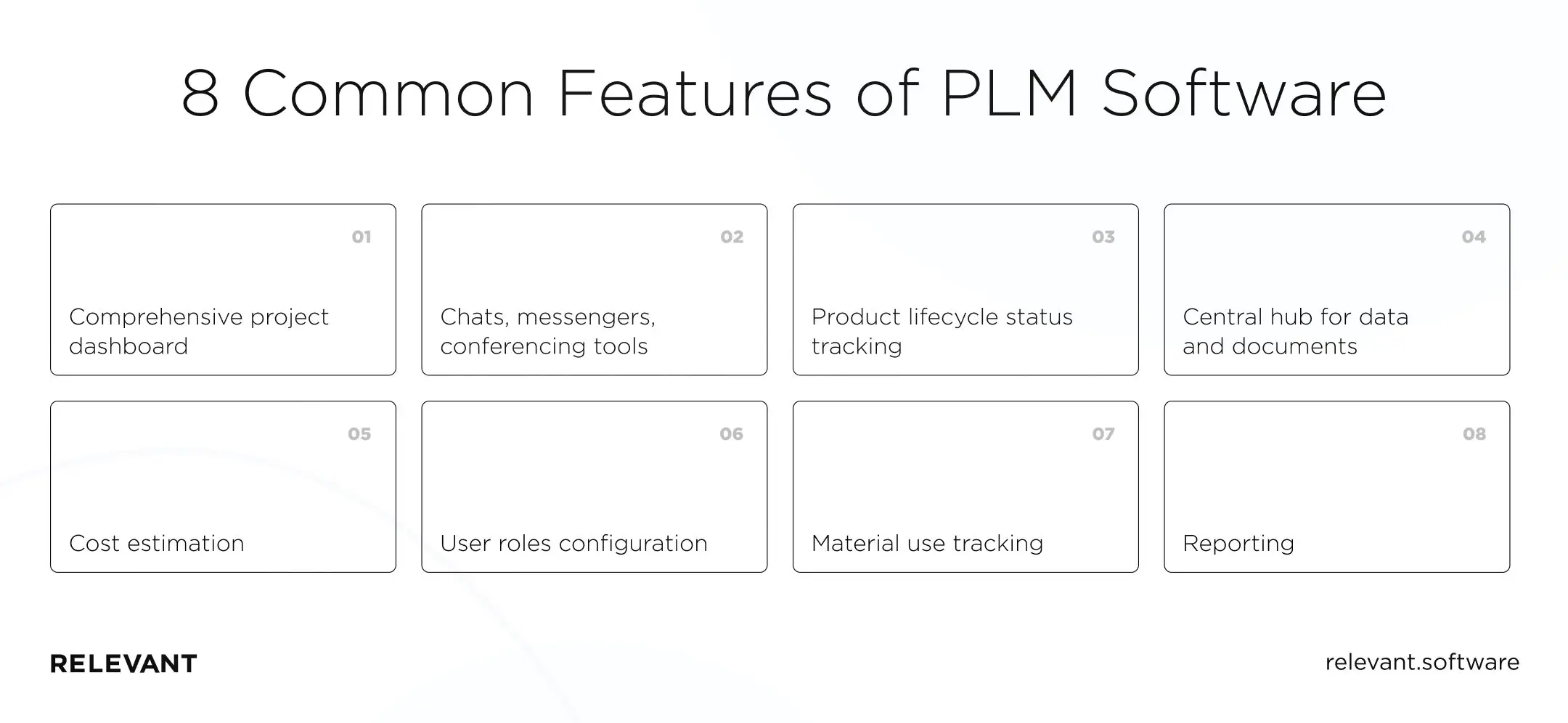
The key capabilities of PLM software are those that enable you to manage:
- Design iterations
- Bills of materials (BOMs) and inventory levels
- Product requirements and compliances
- Product quality and feedback-based improvements
- Manufacturing and commercialization processes
- Collaboration workflows
- Product changes
Specialized product lifecycle management applications can also provide additional features and capabilities. But they are often industry-specific or tailored to companies with unique workflows.
Key steps of PLM software development
Software development isn’t low-hanging fruit on the face of it. But when you know what to do and how to do it consistently, you can get more easily from A to Z—even when it comes to PLM software development.
This brief guide will get you to Z with less hassle:
- Answer the whys. You don’t develop PLM software solutions without knowing why you need them. So first off, determine why you want to adopt one and why it’ll help your product managers get the job done better.
- Gather requirements. Before searching for dedicated software development teams, create a list of features, capabilities, and process requirements for your future PLM app. This will help further the process.
- Hire a development team. Engage whoever is going to use your would-be PLM software (product managers, engineers, designers, etc.) when hiring developers. Your employees will help communicate the problems the software should address.
- Plan, design, and develop. Outline the milestones and decide on the PLM software architecture that hits the target for your business processes. Then let your development team design the frontend and put the code behind it. Be crystal-clear about what UI/UX features are vital for you.
- Implement. When the PLM backend is smooth, shiny, and pre-tested, you can deploy your solution. Make sure it’s configured for your product management processes and systems.
- Integrate your PLM. PLM software is just another system unless it works in harmony with your other external and internal systems. Get your development team to connect it to all the data, processes, and software you use for product management.
- Touch it up as your teams use it. You may find yourself hamstrung by duplicate data or non-optimized processes after your system is released. Your developers should work this out as you continue to utilize PLM software.
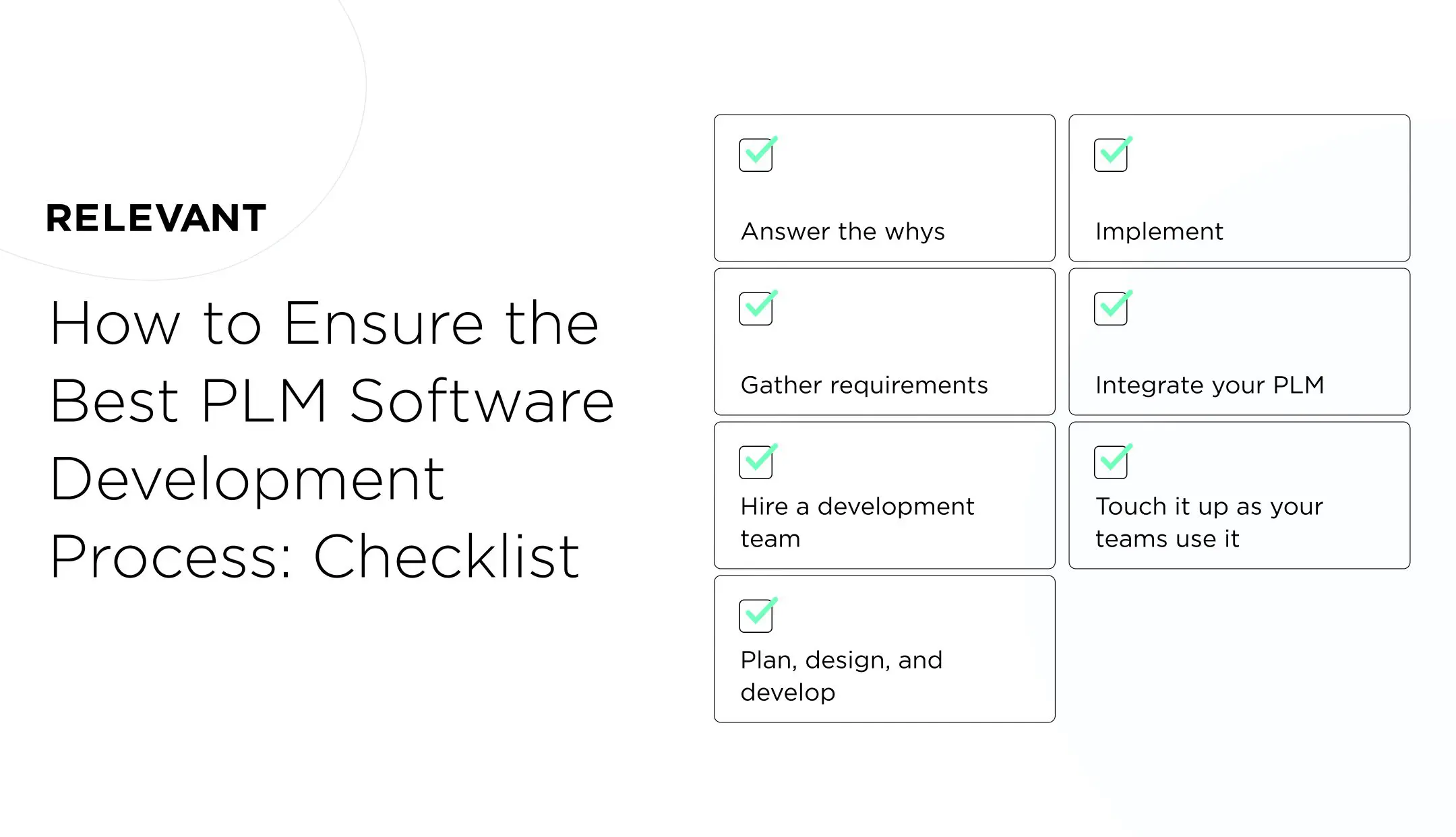
It’s also a good idea to set up a training program for your teams before creating PLM software. Help your product managers, procurement specialists, and other employees acquire the required skills of operation to prevent them from getting stuck in a new system after its rollout.
PLM integration
Bringing PLM software and other enterprise systems together is a big—and highly necessary—step in adopting PLM. If you think a PLM solution can deliver never-before-seen efficiency of its own accord, you’re wrong.
If left non-integrated, PLM software may cause more harm than good for your product management. It may hinder collaboration within your company by leaving your teams with inconsistent and repetitive tasks. When product-related data is walled in by PLM tools so that other systems can’t access it, your employees spend unnecessary time entering the same data.
To cap it off, non-integrated PLM software is often associated with missing things. For example, if product design changes aren’t passed on to the systems your procurement specialists and engineers use, your product improvements are delayed at best. This also goes for updates from your partners that may get lost in transit if your systems are disparate.
That’s why you should integrate your PLM software with your systems enterprise-wide. This includes document exchange tools, enterprise resource planning (ERP) software, computer-aided design (CAD) solutions, customer relationship management (CRM) systems, and others.
Development and integration challenges
Bad news: it is rarely possible to build, integrate, and jumpstart PLM software without having to navigate a bevy of challenges. They arise for every enterprise, small or large, and manifest themselves as:
- Compatibility challenges (when you already have some PLM software)
- Product data challenges (when your product data is at risk of being improperly stored, analyzed, or exchanged)
- Software functionality challenges (when PLM is adopted as a SaaS solution and only meets your product management needs to an extent)
- Legacy systems and outdated management processes (when you can’t implement PLM until you transform your other systems and processes)
- Skill-related challenges (when your teams aren’t professionally capable of embracing new technology in the workspace)
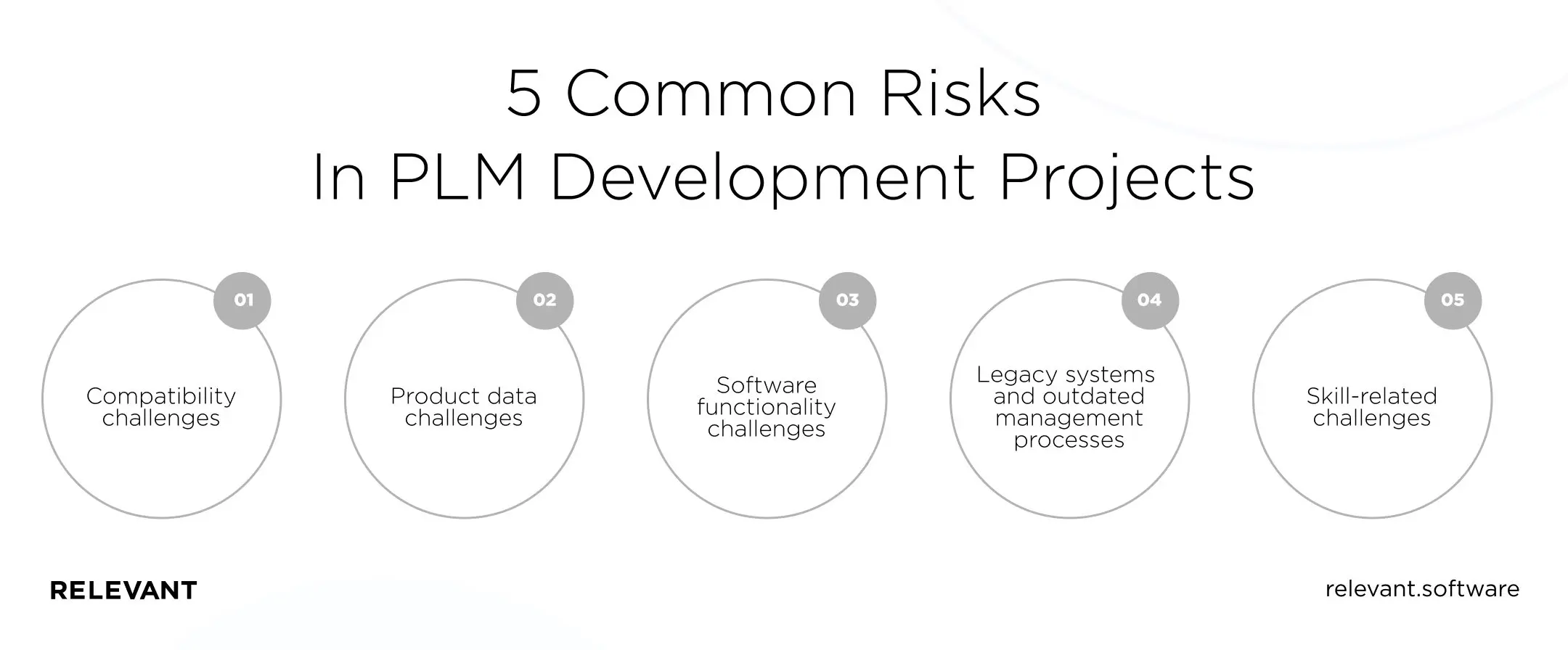
Good news: these challenges aren’t insurmountable. It all comes down to how good your development team is and how high the Internet of Things (IoT) is on your PLM software list.
PLM in the IoT landscape
With zettabytes of data coming from IoT devices, you need to set up a resilient environment where it can be stored, monitored, and managed. PLM software can become the foundation of this environment. By capturing real-time IoT data and linking it to your systems, it can work wonders for your analysis and product value. Here are a few examples of how PLM software can help businesses that use IoT products:
- When creating IoT solutions, you can use various types of PLM software for data modeling, management, and analytics. They are especially effective in cloud-based versions, moving your development beyond storage and scalability barriers.
- When integrated with your IoT solution in the cloud, PLM software speeds up your take-offs and streamlines connections with other IoT devices. This results in a smoother layered product that delivers a user-centric experience and can be further developed with built-in artificial intelligence (AI).
- If you use IoT devices when designing, manufacturing, or maintaining your products, a PLM system can become your decision-making center. Structured IoT data lets you visualize how your product is doing and request real-time BOM or requirement changes.
- Besides, you can hash out predictions within and beyond PLM, such as supply chain problems or a nosedive in product demand. Your decision-makers are in for a treat as IoT-driven PLM software connects data with your resource planning and field performance stats.
Whichever side you’re on, PLM and IoT are an excellent match. And Relevant can help you with both PLM and IoT software development.
It’s your move
A product lifecycle management app or web-based system allows your teams to manage your product’s journey using the tools they want without data discrepancies. Such an interconnected workspace provides integrated accuracy and helps you make every product launch a success.
A custom PLM solution unlocks the most tangible product management benefits since its features and capabilities aren’t pre-defined by a SaaS vendor. If you don’t want to overpay, you can always hire remote developers with hourly rates lower than in your country. Given Ukraine’s outsourcing climate and access to talent, building a development team abroad should be on the ticket.
Relevant has expensive expertise in PLM software development. As your remote team, we can create custom yet cost-effective solutions, whether you’re a startup or a multi-facility manufacturer looking to connect your global devices to a single system. Our portfolio means Relevant is up for whatever you need to develop.
We’ve already run some large-scale software projects with an eye to IoT, including:
- Sensor Innovation: a smart water leak detection solution complete with real-time sensor data monitoring.
- Airthings: a unified system that registers data from radon and air quality monitors and triggers automated alerts.

So, stop flying blind as you develop products or handle IoT data. Contact Relevant to discuss your PLM software project.



